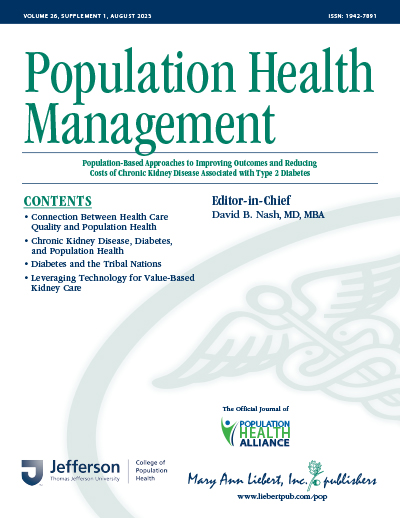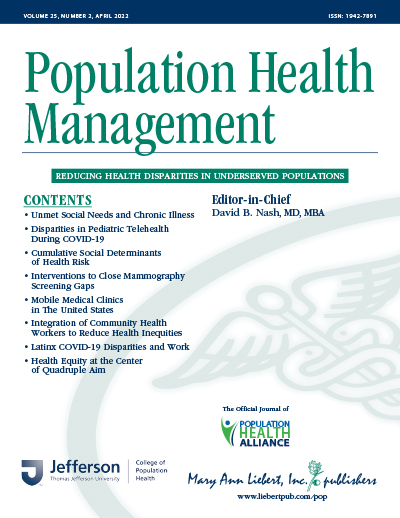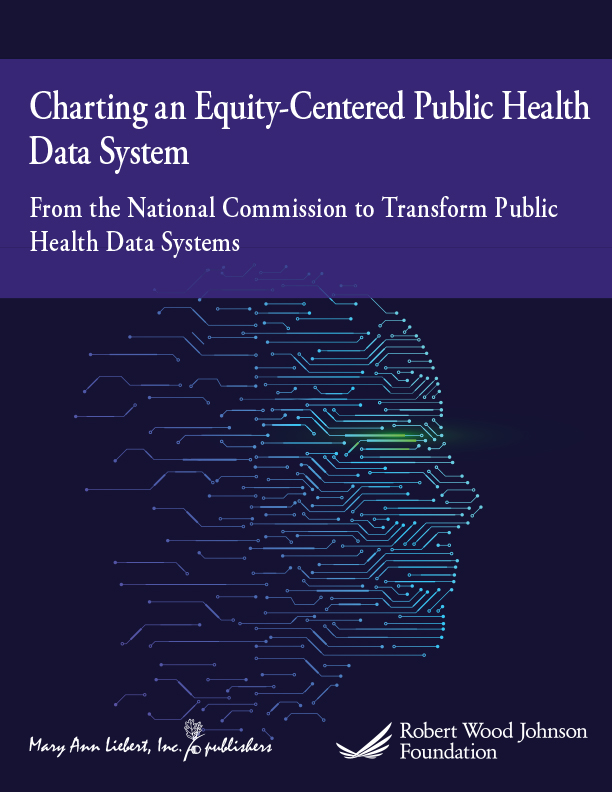Announcements
-
Special Article Collection
National Minority Health Month - Read Now
Featured Content

Supplement
Population-Based Approaches to Improving Outcomes and Reducing Costs of Chronic Kidney Disease Associated with Type 2 Diabetes
Bayer partners with health care leaders to advance health care delivery through research, collaboration, and innovation. The idea for this supplement germinated from 3 educational events Bayer sponsored in 2022. These events (2 webinars and a mini-summit session at the 2022 Population Health Colloquium) provided a platform for discussing chronic kidney disease management in the context of population health. Experts' summaries of their presentations at these events are included in this supplement.
READ MORESponsored by: Bayer

Supplement
Reducing Health Disparities in Underserved Populations
No single citizen can receive high quality care until we all can. This special issue brings together the top thought leaders from across the nation to tackle one of the biggest challenges in our industry. At the core of a just society is our ability to reduce inequality in health care.
READ MOREPress
Food Insecurity and Hospital Visits - Is There a Link?
Having access to adequate and appropriate food is a major population health issue. This study investigated food insecurity in patients with high rates of inpatient hospitalization (“super-utilizers”). Forty adults with =3 hospital inpatient admissions within a 12-month period were interviewed in an urban hospital in Philadelphia, Pennsylvania, between March 2015 and May 2015. Inpatient admission history was obtained from hospital billing data. The majority had =5 hospitalizations in the past 12 months and =6 chronic conditions. Using the USDA definition of food insecurity, 30% (95% CI, 17% to 47%) were food insecure and 25% (95% CI, 13% to 41%) were marginally food secure. Forty percent responded that, in the past 30 days, they worried that their food would run out; 35% that their food would not last; 17.5% that they did not eat for a full day; and 10% that they were hungry but did not eat some or all of the time. Additionally, 75% were unable to shop for food on their own and 58% were unable to prepare their own food. More than half reported using food pantries or other community food resources. The impact of unmet food needs on hospital super-utilization warrants further investigation. Interventions that educate and connect patients with unmet food needs to community resources can help engage patients in their own health and well-being. Communication with patients about whether they have enough nutritionally appropriate food for their health conditions is an important starting point.
READ MOREPress
Expert Panel Urges New Approaches to Curtail U.S. Opioid Epidemic
The American Opioid Epidemic: Population Health Implications and Potential Solutions. Report from the National Stakeholder Panel Janice L. Clarke, RN, Alexis Skoufalos, EdD, and Richard Scranton, MD, MPH Editorial: David B. Nash, MD, MBA S-1 Introduction S-1 The Evolution of Opioid Use in the United States S-2 Unintended Consequences of Postsurgical Pain Management S-2 Pivotal Role of Postsurgical Prescribing Practices S-3
The Case for Multimodal Pain Management for Surgical Patients S-4 Optimizing Health Outcomes S-4 Optimizing Economic Outcomes by Managing Pain Differently S-6 Expert Panel Insights S-7 Conclusion S-7 READ MOREPress
Can Health Coaches Improve Care of Insured Patients with Chronic Diseases?
Health coach programs using low-cost unlicensed providers have largely targeted uninsured or underserved populations, raising questions about uptake and effectiveness for insured patients. This observational study evaluated the referral process, uptake, and effectiveness of a health coach program for patients with diabetes and/or hypertension at a multispecialty clinic. Data included appointment observations; interviews with patients, physicians, and health coaches; patient and physician characteristics; and measures of utilization and clinical outcomes. Out of 1313 eligible patients, 308 (23.5%) were referred over a 12-month period and 169 (54.9%) had at least 1 health coach appointment. Although the health coach program did not change patients" biometrics, physicians and patients reported improved care processes and reduced physician workload. Barriers to enrollment included variability in physician referral practices, patient willingness, and scheduling difficulties. Modifications to physician and health coach workflow are needed to determine the program"s true effectiveness.
READ MOREPress
Successful Model for Statewide Collaborative Initiative to Reduce Avoidable Hospital Readmissions
Increasing scrutiny of hospital readmission rates has spurred a wide variety of quality improvement initiatives. The Preventing Avoidable Readmissions Together (PART) initiative is a statewide quality improvement learning collaborative organized by stakeholder organizations in South Carolina. This descriptive report focused on initial interventions with hospitals. Eligible participants included all acute care hospitals plus home health organizations, nursing facilities, hospices, and other health care organizations. Measures were degree of statewide participation, curricular engagement, adoption of evidence-based improvement strategies, and readmission rate changes. Fifty-nine of 64 (92%) acute care hospitals and 9 of 10 (90%) hospital systems participated in collaborative events. Curricular engagement included: webinars and coaching calls (49/59, 83%), statewide in-person meetings (35/59, 59%), regional in-person meetings (44/59, 75%), and individualized consultations (46/59, 78%). Among 34 (58%) participating hospitals completing a survey at the completion of Year 1, respondents indicated complete implementation of multidisciplinary rounding (58%), post-discharge telephone calls (58%), and teach-back (32%), and implementation in process of high-quality transition records (52%), improved discharge summaries (45%), and timely follow-up appointments (39%). A higher proportion of hospitals had significant decreases (=10% relative change) in all-cause readmission rates for acute myocardial infarction (55.6% vs. 30.4%, P=0.01), heart failure (54.2% vs. 31.7%, P=0.09), and chronic obstructive pulmonary disease (41.7% vs. 33.3%, P=0.83) between 2011–2013 compared to earlier (2009–2011) trends. Focus on reducing readmissions is driving numerous, sometimes competing, quality improvement initiatives. PART successfully engaged the majority of acute care facilities in one state to harmonize and accelerate adoption of evidence-based care transitions strategies. (Population Health Management 2016;19:4–10)
READ MORESociety Affiliations
The Official Journal of:


